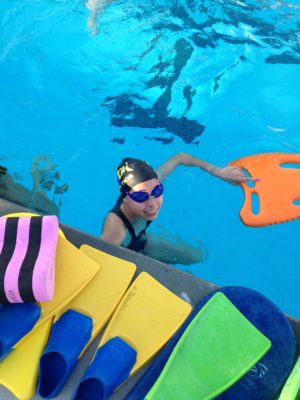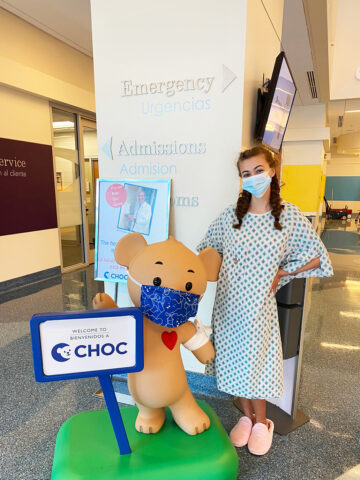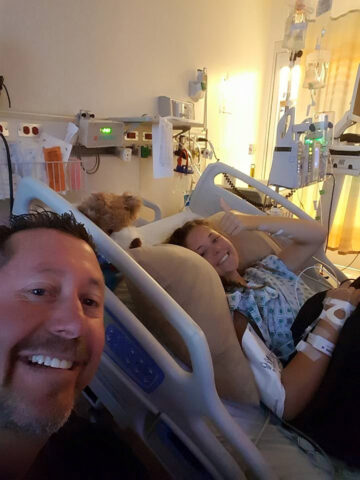By Jennifer Schultz, CHOC patient
At 8 years old, I was diagnosed at the CHOC Orthopedic Institute with idiopathic scoliosis. As a young child, I was not aware of the significance of this lifelong three-dimensional curvature. My baby blue night brace arrived two weeks later. It was a warm insulator around my spine during chilly winters, but during summers it turned into a sweltering, body-hugging, coil-wrapped anaconda. Over the years, wearing my brace was simply part of my nightly routine; the only modification was the arrival of a pink brace, a green one, and finally a gray brace, each increasing in size.
I experienced a major growth spurt – and an increase in the curvature of my spine – in middle school. Up to this point, playing tennis and the piano had been my go-to activities. Even though my doctor disclosed that tennis had no negative impact on my spinal curvature development, my family decided I should discontinue my daily practices, as well as play the piano fewer hours each week. We decided swimming would be a balanced and safe exercise. I started swim year-round with a local club, SOCAL Aquatics, to improve and strengthen my core and back muscles. I was not a big fan of the cold water, especially during the chilly winter nights, and this resulted in my wearing an embarrassing wetsuit for every practice. Quitting tennis and starting swimming were very difficult to accept, but I knew if I continued swimming, I would benefit in the end.
Wearing a brace and swimming year-round have helped maintain my fixed curvature. A few years ago, Dr. Afshin Aminian, medical director of CHOC’s Orthopedic Institute, directed me to the CHOC website, which contained several sets of exercises for patients with scoliosis. I started doing these stretches every day in my room for about 20 minutes. I also began SCHROTH physical therapy to improve posture and reduce progression of the curve. Doing daily breathing and walking exercises are very therapeutic and soothing to my mind and body. With enough practice and concentration, I can utilize these routines in the future should I start to feel discomfort in my back.

Two years after my growth spurt, my doctor prescribed a day brace. The shift from a night brace to a day brace proved to be even tougher on me both physically and mentally, especially since I was required to wear my brace to school. Not only was this a little humiliating, but it was very difficult to sit at a desk and maneuver around campus. The stretch marks, bruises and rashes on my back didn’t make my diagnosis any easier to accept. However, this brace was the only tool preventing my back from succumbing to a more dangerous fate: surgery. Always trying to maintain a more positive outlook has been tricky, but it has helped me minimize some of my discomfort and understand my condition could be much worse if I did not have access to a medical brace.
When I entered my freshmen year of high school, I noticed several of my friends were also wearing spinal day braces. Loose clothing became the norm for us, articles that would discreetly conceal the uneven protrusions of our braces. I empathized with my friends about some of the humiliation and discomfort of scoliosis. This was what motivated me to start a high school health club to promote healthy lifestyles and raise awareness for various health issues, including scoliosis. My vision included fundraising for orthopedic research in local hospitals and POSNA (Pediatric Orthopedic Society of North America). We sold Jamba Juice BOGO cards. Our funds helped a research project on the physiological effects on adolescent scoliosis patients. This study revealed that most teenagers with scoliosis have reduced self-esteem due to their physical appearance, and they do not share these feelings with their parents. In addition, we donated $750 to Dr. Aminian’s current research at CHOC, which is focused on utilizing ultrasound for early scoliosis detection and monitoring. This research is personal to me since I was exposed to X-rays two to three times a year to measure my spinal curvature. The ultrasound is less harmful to patients’ health, and early detection is key to prevent progression.
After eight long years of wearing a back brace, my spine has finally stabilized at a solid 45 degrees. My four braces currently sit inside my closet, each representing a challenge I was able to overcome. Wearing a brace was my greatest hardship. Avoiding back surgery was my greatest triumph. Persistence and dedication are key; keeping the brace on long as possible is the smartest thing to do. I learned that the opinions of my peers should be low on the priority list; my well-being is far more significant. What I realized most is that my brace ultimately made me mentally and physically stronger. Scoliosis made me understand how I could make a difference by supporting the cause and my peers.
Fundraising for scoliosis research was an unforgettable experience that allowed me to assist my friends and other patients with scoliosis. As I learned more about orthopedic research, I wanted to delve deeper into biological laboratories to understand and discover the underlying cause of scoliosis. I recently earned an opportunity to work in a local lab, where I assisted in the study of cell polarity and craniofacial development in zebrafish. Currently, the lab is using zebrafish with scoliosis to study potential mutants or mechanisms that cause idiopathic scoliosis. Although recent publications may offer reasons for the cause of congenital scoliosis in humans, the cause of idiopathic scoliosis remains a mystery in zebrafish and humans.
After acquiring hands-on experience and deeper scientific knowledge in the lab, I would like to attend a college that allows me to do undergraduate research in the fields of cell biology and genetics. My ultimate goal is to graduate with a PhD in cell biology and become a lab researcher to potentially find the cause to conditions and diseases that have similar characteristics to idiopathic scoliosis. My dream is to help unlock the code and find a cure for many childhood ailments.
Get more expert health advice delivered to your inbox monthly by subscribing to the KidsHealth newsletter here.
Learn more about CHOC’s Orthopedic and Sports Medicine Services
Our team of board-certified specialists and orthopedics-trained staff provide a full spectrum of care for disorders of the bones, joints, ligaments, tendons and muscles.





